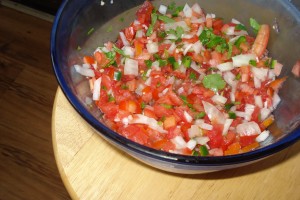My dad suggested a few weeks ago that we try to make salsa from the vegetables in his garden. I easily got on board with this idea, but had to break it to him that we would need more than his garden offers. Luckily, though, his plentiful tomatoes offered an excellent base for a fundamental salsa recipe.
 I had never made fresh salsa, per se, but I did have some starting expertise from two sources. First, I’ve made a good bit of guacamole in my day, and the ingredients are similar (sans avocado, of course). Second, my friend and chef mentor of yesteryear, Lisa, used to make salsa and advised me on the key to her approach-namely, that vegetables should be diced small in a careful and deliberate way, not pulverized in a food processor. I never attempted salsa back in my college days, but I remembered her advice and remembered the very particular and positive effect it had on her salsa recipe.
I had never made fresh salsa, per se, but I did have some starting expertise from two sources. First, I’ve made a good bit of guacamole in my day, and the ingredients are similar (sans avocado, of course). Second, my friend and chef mentor of yesteryear, Lisa, used to make salsa and advised me on the key to her approach-namely, that vegetables should be diced small in a careful and deliberate way, not pulverized in a food processor. I never attempted salsa back in my college days, but I remembered her advice and remembered the very particular and positive effect it had on her salsa recipe.
SARAH’S FRESH SALSA
2-3 lbs. medium tomatoes, just ripe (flesh should be firm, not grainy)
1 large onion
1 teaspoon minced garlic
1 jalapenos, or other hot pepper to taste
juice of 1 lime
cilantro, several sprigs, to taste
salt and pepper, to taste
Quarter the tomatoes, seed them, rinse clean and then place on a paper towels to dry a bit.
Meanwhile, dice the vegetables. All vegetables should be chopped into small pieces, but not so small that they lose their shape (as would happen in pulverized in a food processor). This process isn’t as labor intensive as you might think. Onions can be sliced first to create rings, and the cut into tiny cubes against the grain of its natural layers. Slice peppers in half length-wise, seed them, and then cut long, slender strips. Make slender cuts in the other direction, now, to make small pieces. Once tomatoes have dried a bit, do the same.
Combine diced onion, minced garlic, chopped jalapenos, and chopped tomatoes in a medium bowl. Juice the lime over the bowl. Snip the cilantro into the mix, and season to taste with salt and pepper. Let stand in the refrigerator at least a half hour. I usually try to make it a day ahead of time to let the flavors meld together. Serve with chips or tacos or any dish to which salsa is a good compliment.


